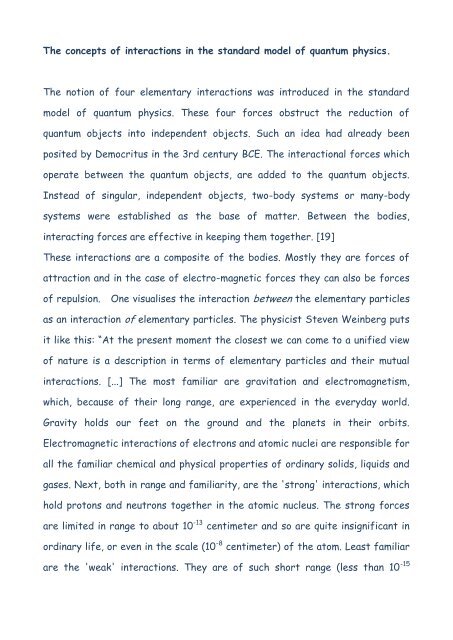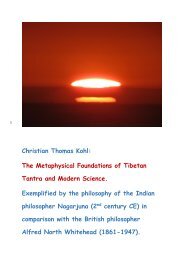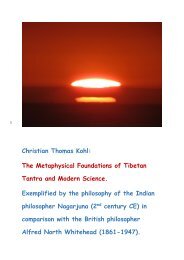The Metaphysical Foundation of Buddhism and Modern Science
The Metaphysical Foundations of Buddhism and Modern Science: Nagarjuna and Alfred North Whitehead
The Metaphysical Foundations of Buddhism and Modern Science: Nagarjuna and Alfred North Whitehead
You also want an ePaper? Increase the reach of your titles
YUMPU automatically turns print PDFs into web optimized ePapers that Google loves.
<strong>The</strong> concepts <strong>of</strong> interactions in the st<strong>and</strong>ard model <strong>of</strong> quantum physics.<br />
<strong>The</strong> notion <strong>of</strong> four elementary interactions was introduced in the st<strong>and</strong>ard<br />
model <strong>of</strong> quantum physics. <strong>The</strong>se four forces obstruct the reduction <strong>of</strong><br />
quantum objects into independent objects. Such an idea had already been<br />
posited by Democritus in the 3rd century BCE. <strong>The</strong> interactional forces which<br />
operate between the quantum objects, are added to the quantum objects.<br />
Instead <strong>of</strong> singular, independent objects, two-body systems or many-body<br />
systems were established as the base <strong>of</strong> matter. Between the bodies,<br />
interacting forces are effective in keeping them together. [19]<br />
<strong>The</strong>se interactions are a composite <strong>of</strong> the bodies. Mostly they are forces <strong>of</strong><br />
attraction <strong>and</strong> in the case <strong>of</strong> electro-magnetic forces they can also be forces<br />
<strong>of</strong> repulsion. One visualises the interaction between the elementary particles<br />
as an interaction <strong>of</strong> elementary particles. <strong>The</strong> physicist Steven Weinberg puts<br />
it like this: “At the present moment the closest we can come to a unified view<br />
<strong>of</strong> nature is a description in terms <strong>of</strong> elementary particles <strong>and</strong> their mutual<br />
interactions. [...] <strong>The</strong> most familiar are gravitation <strong>and</strong> electromagnetism,<br />
which, because <strong>of</strong> their long range, are experienced in the everyday world.<br />
Gravity holds our feet on the ground <strong>and</strong> the planets in their orbits.<br />
Electromagnetic interactions <strong>of</strong> electrons <strong>and</strong> atomic nuclei are responsible for<br />
all the familiar chemical <strong>and</strong> physical properties <strong>of</strong> ordinary solids, liquids <strong>and</strong><br />
gases. Next, both in range <strong>and</strong> familiarity, are the 'strong' interactions, which<br />
hold protons <strong>and</strong> neutrons together in the atomic nucleus. <strong>The</strong> strong forces<br />
are limited in range to about 10 -13 centimeter <strong>and</strong> so are quite insignificant in<br />
ordinary life, or even in the scale (10 -8 centimeter) <strong>of</strong> the atom. Least familiar<br />
are the 'weak' interactions. <strong>The</strong>y are <strong>of</strong> such short range (less than 10 -15


















